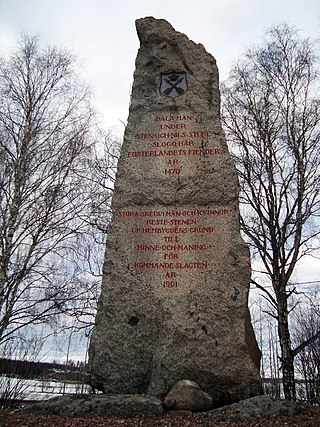
The Kalmar Union was a personal union in Scandinavia, agreed at Kalmar in Sweden as designed by widowed Queen Margaret of Denmark. From 1397 to 1523, it joined under a single monarch the three kingdoms of Denmark, Sweden, and Norway, together with Norway's overseas colonies.

Eric of Pomerania ruled over the Kalmar Union from 1396 until 1439. He was initially co-ruler with his great-aunt Margaret I until her death in 1412. Eric is known as Eric III as King of Norway (1389–1442), Eric VII as King of Denmark (1396–1439) and has been called Eric XIII as King of Sweden. Eric was ultimately deposed from all three kingdoms of the union, but in 1449 he inherited one of the partitions of the Duchy of Pomerania and ruled it as duke until his death in 1459. His epithet of Pomerania was a pejorative intended to insinuate that he did not belong in Scandinavia.

Christian I(Christiern I) was a German noble and Scandinavian monarch under the Kalmar Union. He was king of Denmark (1448–1481), Norway (1450–1481) and Sweden (1457–1464). From 1460 to 1481, he was also duke of Schleswig and count of Holstein. He was the first king of the House of Oldenburg.

Kettil Karlsson (Vasa) (c. 1433 – 11 August 1465) was a Swedish clergyman, diplomat, military leader and statesman during the Kalmar Union era. He was a member of the house of Vasa. At age 25, he was elected Bishop of Linköping. He rebelled against King Christian I in 1463, was Captain General (rikshövitsman) and de facto regent of Sweden from February to August 1464, stepping down during the brief return of King Charles Canutesson from exile. After falling out with King Charles, Kettil Karlsson was subsequently elected Lord Protector and Regent (riksföreståndare) of Sweden from 26 December 1464 to his death.

Karl Knutsson Bonde, also known as Charles VIII and called Charles I in Norwegian contexts, was King of Sweden and King of Norway (1449–1450).

Dorothea of Brandenburg was Queen of Denmark, Norway, and Sweden under the Kalmar Union as the consort of first King Christopher III of Denmark and later King Christian I of Denmark. She served as interim regent during the interregnum in 1448 and as regent in the absence of her second spouse during his reign. She and Christian had three surviving children: John, Margaret, and Frederick, of whom John served as king of the union and both sons served as kings of Denmark and Norway.

The Engelbrekt rebellion (Engelbrektsupproret) was an uprising during 1434–1436 led by Swedish miner and nobleman Engelbrekt Engelbrektsson and directed against Eric of Pomerania, the king of the Kalmar Union. The uprising, with its center in Dalarna and Bergslagen, spread throughout Svealand and Götaland. The rebellion caused erosion within the unity of the Kalmar Union, leading to the temporary expulsion of Danish forces from Sweden.
The Fief of Viborg (1320–1534) was for two centuries a late medieval fief in the southeastern border of Finland and the entire Swedish realm. It was held by its chatelain, a fief-appointed feudal lord.
Arvid Birgersson, Lord of Bergkvara was a Swedish magnate and politician in the last decades of Middle Ages. He was justiciar of Östergötland and then of Tiohärad, as well as a Lord High Councillor of Sweden, and once a candidate for Regent. His family coat of arms depict a headless troll whereby some have retrospectively called him Arvid Trolle.
Christina Abrahamsdotter (1432–1492) was a Finnish woman, royal mistress and briefly queen of Sweden as the third wife of King Charles VIII.

Jöns Bengtsson (Oxenstierna), in Latin known as Johannes Benedicti de Salista, was a Swedish clergyman, canon law scholar and statesman who served as Archbishop of Uppsala (1448–1467). He was the also the regent of Sweden under the Kalmar Union in 1457, shared with Erik Axelsson (Tott), and alone from 1465 to 1466.

Magdalena of Sweden was a Swedish princess. She was the daughter of Charles VIII of Sweden and his first queen consort, Catherine Karlsdotter. In 1468–1470, her spouse Ivar Axelsson (Tott) was the promised successor of her father as regent.
The Battle of Haraker was fought on 17 April 1464 at the village of Haraker, Västmanland, approximately 20 kilometers north of the city of Västerås in Sweden. The Swedish separatist army, under the command of the Bishop of Linköping, Kettil Karlsson, defeated King Christian I's Danish army.
Ture Turesson (Bielke) (1425–1489/90) was a Swedish statesman and military commander and a prominent leader of the unionist party during the Kalmar Union period. He was a Privy Councillor and Castellan of Axvall Castle during the reign of separatist King Charles Canutesson, before defecting to the unionist side in 1452, spending several years in exile in Denmark. He was appointed Lord High Constable of Sweden, Castellan of Stockholm and Kalmar and Captain-General during the reign of King Christian I, and commanded the unionist forces during several major battles during the turbulent 1460s, before surrendering to Sten Sture the Elder's separatists in 1472. During his later years he was Lawspeaker of the province of Öland.

The Battles of Kopparberget and Opphöga ferry were a series confrontations between an insurgent army under Erik Karlsson Vasa and a Dalecarlian army led by Sten Sture the Elder, and Nils Sture at Kopparberget and Opphöga ferry in 1470. The battles resulted in a defeat for the insurgents.